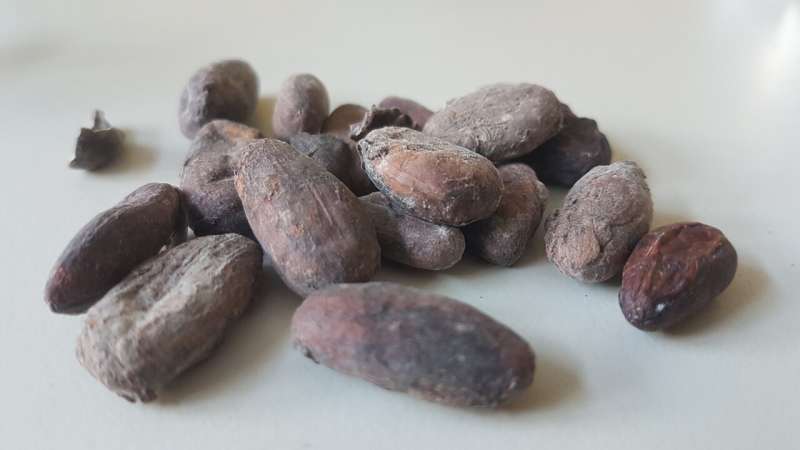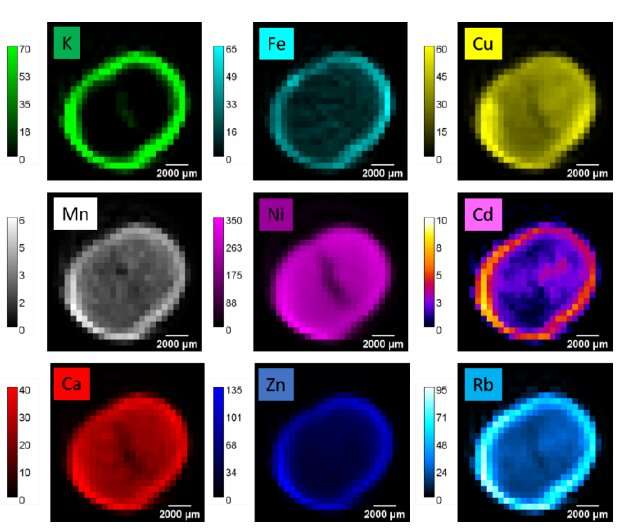This article has been reviewed according to Science X's editorial process and policies. Editors have highlighted the following attributes while ensuring the content's credibility:
fact-checked
peer-reviewed publication
trusted source
proofread
How much cadmium is contained in cocoa beans?

Cocoa beans can absorb toxic heavy metals such as cadmium from the soil. Some cultivation areas, especially in South America, are polluted with these heavy metals, in some cases considerably. In combining different X-ray fluorescence techniques, a team at BESSY II has now been able to non-invasively measure for the first time where cadmium accumulates exactly in cocoa beans: Mainly in the shell.
The work is published in the journal Analytical Chemistry, and further investigations show that the processing of the cocoa beans can have a great influence on the concentration of heavy metals.
People have been harvesting the beans of the cocoa bush for at least 5,000 years. They have learned to ferment, roast, grind and process the beans with sugar and fat to make delicious chocolates. Today, around 5 million tons of beans are on the market every year, coming from only a few growing areas in tropical regions.
Chocolate is considered a soul food: amino acids such as tryptophan brighten the mood. Cocoa beans also contain anti-inflammatory compounds and valuable trace elements. However, cocoa plants also absorb toxic heavy metals if the soils are polluted, for example by mining, which can gradually poison groundwater and soils.
An important question is, where exactly the heavy metals accumulate in the bean, whether rather in the shell or rather in the endosperm inside the bean. From the harvest to the raw material for chocolate, the beans undergo many steps of different treatments, which could possibly reduce the contamination. And ideally the treatment could be optimized in order to make sure that the heavy metals are reduced but the desirable trace elements are retained.
Mapping the beans at BESSY II
A team led by Dr. Ioanna Mantouvalou (HZB) and Dr. Claudia Keil (TU Berlin/Toxicology) has now combined various imaging methods at the BAMline of BESSY II to precisely map the heavy metal concentrations in cocoa beans.
They examined cocoa samples from a cultivation region in Colombia, which were contaminated with an average of 4.2 mg/kg cadmium. This is well above the European limits of 0.1-0.8 mg cadmium/kg in cocoa products.

The team worked with three different X-ray fluorescence techniques to examine the cocoa beans. Among other things, they developed a new analytical method for absorption correction when imaging with an X-ray color camera.
"There has been little understanding of how cadmium migrates from the soil through roots into the plant and where the element accumulates in the beans. Especially because it was not possible to precisely localize the cadmium content non-invasively," says Mantouvalou. Ph.D. students Frank Förste (TU Berlin) and Leona Bauer (TU Berlin and HZB) carried out the experiments.
Cadmium is particularly difficult to detect, explains Mantouvalou. This is because the cadmium signal, which produces the excitation of the outer electrons, lies exactly below the much stronger fluorescence signal of the element potassium, which occurs in higher concentrations in cocoa.
"We therefore excite a deeper electron shell of the cadmium atom, which is only possible with hard X-rays at the BAMLine," says Frank Förste. "This enabled us to map the cross-sections of cocoa beans with high resolution, and show that cadmium predominantly accumulates in the outer shell," says Leona Bauer.
They also discovered interesting differences between beans before and after the roasting process. "We were able to prove that roasting changes the element distribution in the beans," says Mantouvalou. The combination of the different experimental methods allows researchers for the first time to precisely measure the accumulation of cadmium. Further investigations could systematically explore how to improve the processing steps in order to minimize the exposure.
More information: Frank Förste et al, Quantitative Analysis and 2D/3D Elemental Imaging of Cocoa Beans Using X-ray Fluorescence Techniques, Analytical Chemistry (2023). DOI: 10.1021/acs.analchem.2c05370
Journal information: Analytical Chemistry
Provided by Helmholtz Association of German Research Centres




















